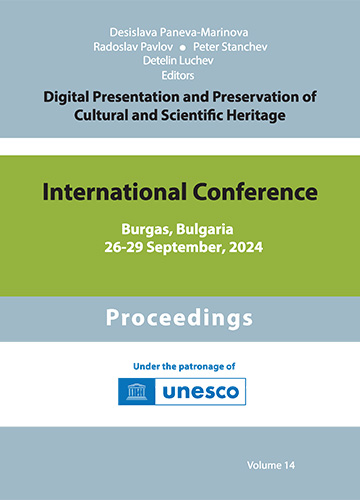Reusing Components from Cultural Heritage Games – the RAGE Project Approach
DOI:
https://doi.org/10.55630/dipp.2016.6.5Keywords:
video games, cultural heritage, applied games, asset model, metadata model, metadata editor, gamificationAbstract
Video games proved to be an attractive media for presenting cultural heritage issues. They can use virtual worlds to present cultural and historic information in amazing and highly appealing way. Each video game is implemented using set of valuable artifacts (components) reflecting technological, socioeconomic and historical issues. These software components are known as software assets, which are key output of the RAGE project. They can be used by game developers to enhance the pedagogical and educational value of their games. These software assets cover a broad spectrum of functionalities, including emotion detection, intelligent adaptation and social gamification. In order to facilitate integration and interoperability, all of these assets adhere to a common model, which describes their properties through a set of metadata. In this paper, we present the RAGE asset model and asset metadata model, highlighting key issues and challenges in constructing RAGE assets and using asset metadata model with flexible metadata editor, facilitating both adaptation and improvement of the asset metadata model.References
Sotirova, K., Peneva, J., Ivanov, S., Doneva, R., Dobreva, M.: Digitization of Cultural Heritage–Standards, Institutions, Initiatives. Chapter 1, Access to Digital Cultural Heritage: Innovative Applications of Automated Metadata Generation, ISBN: 978-954-423- 722-6, Plovdiv, Bulgaria (2012)
Zyda, M.: From Visual Simulation to Virtual Reality to Games. IEEE Computer, Sept., Vol. 38 (9), pp.25-32 (2005)
Anderson, E. F., McLoughlin, L., Liarokapis, F., Peters, C., Petridis, P., & Freitas, S.: Serious games in cultural heritage, Proc. of 10th Int. Symp. on Virtual Reality, Archaeology and Cultural Heritage VAST (2009)
Bontchev, B.: Serious Games for and as Cultural Heritage, in Proc. of the Fifth Int. Conf. on Digital Presentation and Preservation of Cultural and Scientific Heritage, UNESCO, Issue No. 5, Veliko Tarnovo, Bulgaria, Sept. 28–30, pp.43-58 (2015)
RAGE: Project Web site, http://www.rageproject.eu, last visited 30/06/2016
El Borji, Y., Khaldi, M.: An IEEE LOM Application Profile to Describe Serious Games, International Journal of Computer Applications, Volume 86 – No 13, January, (2014)
Portugal, J-N.: Le Rapprochement du Jeu et de l’Apprentissage. Serious Games Summit Europe, Lyon, France (2006)
Djaouti, D., J. Alvarez, J. Jessel, G. Methel, P. Molinier: A Gameplay Definition through Videogame Classification, International Journal of Computer Games Technology, Vol 2008, Article ID 470350, http://dx.doi.org/10.1155/2008/470350 (2008)
Hunicke, R., LeBlanc, M., Zubek, R.: MDA: A formal approach to game design and game research. Proc. of the AAAI Workshop on Challenges in Game AI, Vol. 4, July, (2004)
Zagal, J., Mateas, M., Fernandez-Vara, C., Hochhalter, B. and Lichti, N.: Towards an Ontological Language for Game Analysis, Proc. of the Digital Interactive Games Research Association Conference (DiGRA 2005), Vancouver B.C., June, (2005)
Järvinen, A.: Introducing Applied Ludology: Hands-on Methods for Game Studies. in Situated Play, Proc. of DiGRA 2007 Conference, ACM, pp. 134-144, (2007)
Van der Vegt, W., Nyamsuren, E., Westera, W.: RAGE Reusable Game Software Components and Their Integration into Serious Game Engines. In: Georgia M. Kapitsaki and Eduardo Santana de Almeida (Eds.), Bridging with Social-Awareness, Proc. of 15 th Int. Conf. ICSR 2016, Limassol, Cyprus, June 5-7, 2016, LNCS, Vol. 9679, pp. 165-180 (2016)
Van der Vegt, W., Westera, W., Nyamsuren, E., Georgiev, A., Martínez Ortiz, I.: RAGE Architecture for Reusable Serious Gaming Technology Components, Int. Journal of Computer Games Technology, doi:10.1155/2016/5680526 (2016)
Westera, W., Van der Vegt, W., Bahreini, K., Dascalu, M., Van Lankveld, G.: Software Components for Serious Game Development. Proc. of 10 th European Conf. of Game-Based Learning, October 6-7, 2016, Paisley, Scotland (2016)
Saveski, G. L., Westera, W., Yuan, L., Hollins, P., Fernández Manjón, B., Moreno Ger, P., Stefanov, K.: What serious game studios want from ICT research: identifying developers’ needs. In: A. De Gloria and R. Veltkamp (Eds.), Proc. of the GALA 2015 Conf., December 7-8, Rome, Italy, LNCS 9599, pp. 1–10 (2015)
De Freitas, S., Oliver, M.: A four dimensional framework for the evaluation and assessment of educational games, Computer Assisted Learning, (2005)
Bloom Games Taxonomy: Free Taxonomy Alignment for Gaming, Allen Interactions, http://outreach.alleninteractions.com/poster-taxonomy-alignment-for-gaming-tag/ (2014)
Björk, S., Holopainen, J.: Patterns in Game Design, Charles River Media (2004)
Kiili, K.: Call for learning-game design patterns. Edvardsen, F. & Kulle, H.(eds.). Educational games: design, learning and applications, Nova Publishers (2010)
OMG: Reusable Asset Specification (RAS), Version 2.2, Release Date: November 2005, http://www.omg.org/spec/RAS/2.2/, (2005)
ADMS: Asset Description Metadata Schema (ADMS), W3C proposal standard, (2013)
XML: XML 1.0 Specification, World Wide Web Consortium, (2010)
UML: Unified Modeling Language (UML), revision 2, ISO/IEC 19505-1:2012, (2012)
GitHub API: GitHub Developer Guide (2016) https://developer.github.com/v3/
Lagoze, C., Van de Sompel, H.: The Open Archives Initiative Protocol for Metadata Harvesting, https://www.openarchives.org/OAI/openarchivesprotocol.html (2015)
OpenID: OpenID Connect Specification, retrieved from http://openid.net/developers/specs/ (2014)




